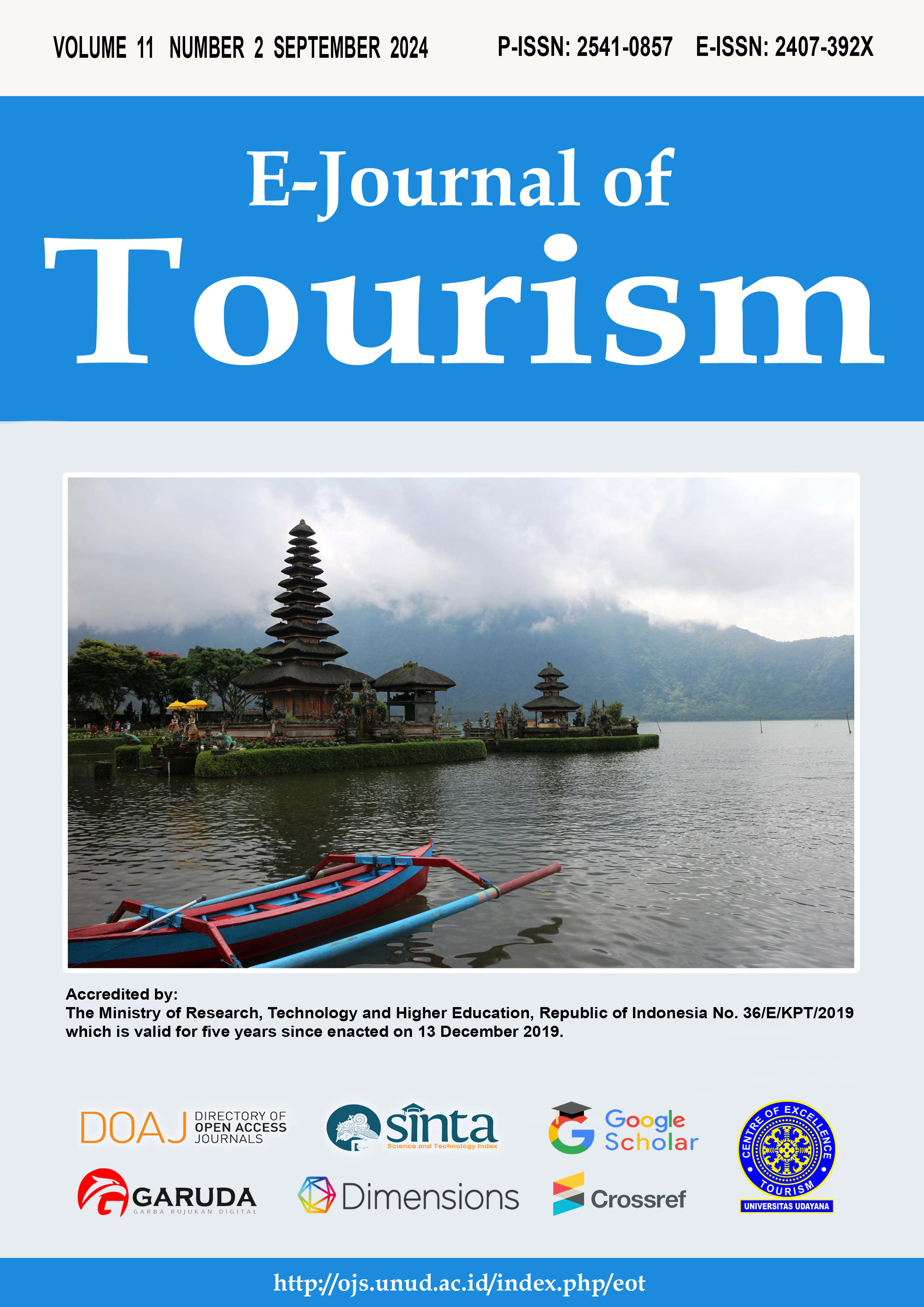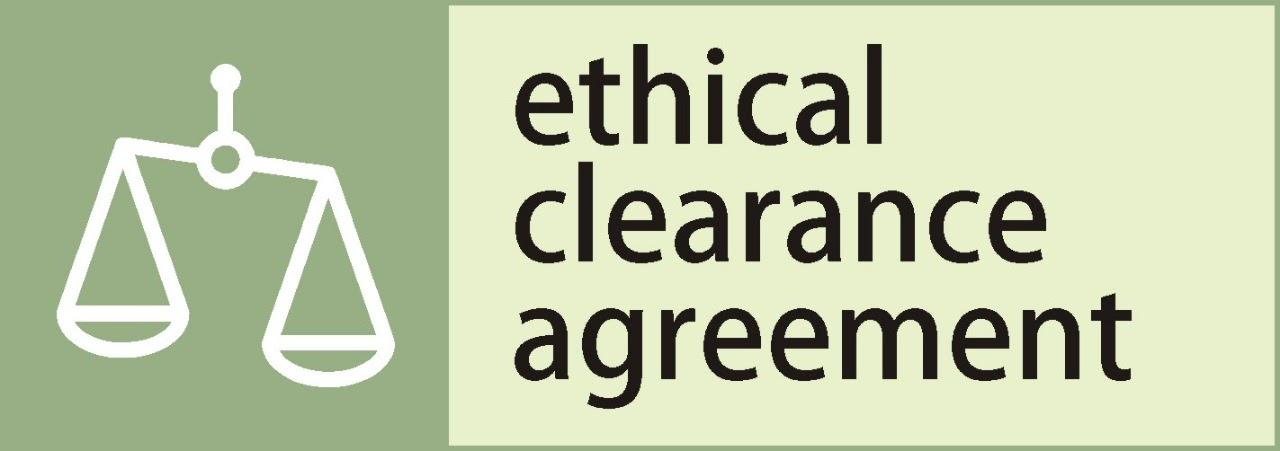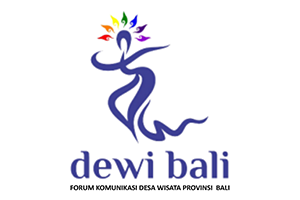Orientation of Stakeholders in the Gayo Highlands on Ecoregional Identity for Ecotourism Development of Gayo Lues District, Aceh Province
Abstract
Directly or indirectly, the development of ecotourism will affect the identity of the Gayo Highlands ecoregion as a living space. On the one hand, it can encourage or become a driving force for the preservation of natural resources and local culture, but on the other hand, it can exacerbate conflicts between stakeholders on ecoregional identities. Therefore, stakeholder orientation towards ecoregional identity for ecotourism development is important to be analyzed and mapped and interpreted in a comprehensive and in-depth manner, such as in Gayo Lues Regency, Aceh Province. This research on Stakeholder Orientation on Ecoregional Identity for Ecotourism Development in Gayo Lues Regency was conducted through an analysis of the perceptions, motivations and preferences of stakeholder groups; adopts the One Score One Criteria Scoring System method on seven aspects of identity, namely aspects of ecology and conservation, socio-cultural, socio-economic, socio-political, development, regional and ecotourism. The results of the analysis show that the orientation of stakeholders towards ecoregion identity is still low, out of 338 identified potential ecoregion identities, only 43% are recognized by stakeholder groups. In general, it can be said that stakeholder orientation is only focused on various ecoregional identity variables that are currently trending and have high economic value. This fact will not only result in the defragmentation of various living ecosystems, but also is latent in causing massive damage and extinction.
Keywords: ecoregional, identity, conflicts, damage, extinction
Downloads
References
Angelia, M., et al. (2010). Social and environmental effect of ecotourism in the Osa Peninsula of Costa Rica: the Lapa Rios case. Journal of Ecotourism, 9(1) 62-83.
Angriani, P., Sumarmi., Ruja, I. N., and Bachri, S. (2018). River Management: The Importance of the Roles of the Public Sector and Community in River Preservation in Banjarmasin (A Case Study of the Kuin River, Banjarmasin, South Kalimantan - Indonesia). Sustainable Cities and Society. https://doi.org/10.1016/j.scs.2018.08.004
Ardoin, N.M., Schub, J. S., Gould, R. K. (2012). Exploring the dimensions of place: a confirmatory factor analysis of data from three ecoregional sites. Journal environmental education Research, l18(5) 583-607.
Astuti, D. (2020). Kedih, Si Monyet Berjambul Asal Sumatera. www.goodnewsfromindonesia.id
Aswita (2021). Optimasi Pemanfaatan dan Perancangan Identitas Ecoregional Etnis Gayo untuk Pembangunan Ekowisata di Dataran Tinggi Gayo, Provinsi Aceh.[Disertasi]. Institut Pertanian Bogor.
Avenzora, R. (2013). Ekoturisme; teori dan implikasi. Darusman, D., Avenzora, R., [editor]. Bogor, Program Pasca Sarjana Manajemen Ekowisata dan Jasa Lingkungan Fakultas Kehutanan, Institut Pertanian Bogor.
Avenzora, R. (2008). Ekoturisme; Teori dan Praktik. Penerbit BRR NAD – NIAS.
Badan Pusat Statistik Kabupaten Gayo Lues. (2018). Gayo Lues Dalam Angka.
Badan Pusat Statistik Kabupaten Gayo Lues. (2017). Gayo Lues Dalam Angka.
Badan Pusat Statistik Kabupaten Gayo Lues. (2016). Gayo Lues Dalam Angka.
Badan Pusat Statistik Kabupaten Gayo Lues. (2015). Gayo Lues Dalam Angka.
Badan Pusat Statistik Kabupaten Gayo Lues. (2014). Gayo Lues Dalam Angka.
Badan Pusat Statistik Kabupaten Gayo Lues. (2013). Gayo Lues Dalam Angka.
Blasi, C., Capotorti, G., Copiz, R., Guida, D., Mollo, B., Smiraglia, D., and Zavattero, L. (2014). Classification and mapping of the ecoregions of the ecoregions of Italy. Plant Biosystems – An International Jounal Dealing with All Aspects of Plant Biology, 148(6), 1255-1345. 5, http://dx.doi.org/10.1080/11263504.2014.985756
Bouma, J., et al. (2012). Ecoregional Approaches for Sustainable Land Use and Food Product. Springer-Science+Business Media, p 1-11.
Bredif, H., Simon, L., & Valenzisi, M. (2017). Stakeholder motivation as a means toward a proactive shared approach to caring for biodiversity: Application on Plateau de Millevaches. Land Use Policy, 61, 12–23. https://doi.org/10.1016/j.landusepol.2016.11.014
Brito, et al. (2016). NGO Partnership in Using Ecotourism for Conservation: Systematic Review and Meta-Abalysis. Plos one, 11(11).
Bruyere, B., and Rappe, S. (2007). Identifying the motivations of environmental volunteers. Journal of Environmental Planning and Management, 50(4), 503–516.
Clayton, S., and Myers, G. (2009). Conservation Psychology; Understanding and Promoting Human Care for Nature. Wiley-Blackwell Publishing, 54-72.
Chiu, H. Y., Chan, C. S., and Marafa, L. M. (2016). Local perception and preferences in nature tourism in Hong Kong. Tourism Management Perspectives, 20, 87–97. https://doi.org/10.1016/j.tmp.2016.07.007
Combinah, P. B. (2015). Contextualising the meaning of ecotourism. Tourism Management Perspectives, (16): 179-189.
Darmawan, R. (2004). Publishing a community-based knowledge-transfer device within the framework of cultural heritage preservation, management, promotion and education. The International Information & Library Review, 36(3), 209–217.
Gayo Lues Agricultural office (2018). Data Potensi Pertanian Kabupaten Gayo Lues.
Gayo Lues Tourism Office (2018). Arsip Data Potensi Pariwisata kabupaten Gayo Lues.
Elliot, J. (2002). Tourism; Politics and Public Sector Management. Taylor and Francis e-Library, 35-37.
Facette, F. F. (2015). Bejamu Saman, Tradisi Turun Temurun Suku Gayo yang Mengakrabkan. www.jawapos.com.
Fatkhiati, S., Tjiptoherijanto, P., Rustiadi, E., and Thayib, M. H. (2015). Sustainable Agropolitan Management Model in the Highland of Tropical Rainforest Ecosystem: The Case of Selupu Rejang Agropolitan Area, Indonesia. Procedia Environmental Sciences, 28, 613–622.
Fossgard, K., & Fredman, P. (2019). Dimensions in the nature-based tourism experiencescape: An explorative analysis. Journal of Outdoor Recreation and Tourism. doi:10.1016/j.jort.2-19.04.001.
Forum Masyarakat Uten Leuser (2014). Rencana Konservasi Bentang Alam Kabupaten Gayo Lues, Provinsi Aceh. Publised United States Agency for International Development.
Hardy, A., and Pearson, L. J. (2017). Examining stakeholder group specificity: An innovative sustainable tourism approach. Jurnal of Destination Marketing & Management. Accepted 5 May 2017. http://dx.doi.org/10.1016/j.jdmm.2017.05.001
Harahap, F. P. (2019). Analisis Komuditi Unggulan Sektor Pertanian di Kabupaten Gayo Lues. [Skripsi]. Universitas syiah Kuala, Banda Aceh.
Heniwaty, Y. (2015). Tari Saman pada Masyarakat Aceh, Identitas dan Aktualisasi. [Disertasi]. Universitas Negeri Medan.
Herisman (2006). Hubungan Persepsi dan Motivasi Kerja Pegawai Administrasi Dalam Rangka Meningkatkan Kinerja pada Pengadilan Negeri Bengkulu. [Thesis]. Universitas Terbuka, Program Pascasarjana Program Studi Administrasi Publik.
Honey, M. (2008). Ecotourism and sustainable development, second edition. Island Press, Washington. p 23-24
Iachetti, P., & Howard, S. C. (2011). A conservation ecoregional assessments for the British Columbia Central interior. BC Journal of Ecosystem and Management, 12(1):1-6.
International Union for Concervation of Nature and Natural Resources. (2012). IUCN Red List Endangered species. [internet]. http://www.iucnredlist.org
Jaenudin,U., dan Marliani, R. (2017). Psikologi Lingkungan. Penerbit CV Pustaka Setia, Bandung.
Jakcson, W. A. (2009). Economics, culture and social theory. Edward Elgar Publishing, p 16-23.
Joni, Linge, Bentara, Luttawar, Hajar, I., at al. (2017). Kerawang Gayo. Tangerang: Mahara Publishing.
Jun, J., Kyle, G., Graefe, A., and Manning, R. (2015). An Identity-Based Conceptualization of Recreation Specialization. Journal of Leisure Research, 47(4), 425–443.
doi:10.1080/00222216.2015.11950369.
Koentjaraningrat (2002). Pengantar Ilmu Antropologi. Penerbit PT Rineka Cipta, Jakarta.
Khostharia, T. K., and Chachava, N. T. (2017). Prospects of ecotourism development in recreation areas of south Georgia. Annals of Agrarian science (15) 312-317.
https://doi.org/10.1016/j.aasci.2017.07.004
KSMTour. (2020). Air terjun kolam biru Rerebe yang memukau di Aceh. www.ksmtour.com
Lee, T.H., & Jan, F. H. (2019). Can community-based tourism contribute to sustainable development? Evidence from residents’ perceptions of the sustainability. Tourism Management, 70, 368–380. doi:10.1016/j.tourman.2018.09.003
Leeuwis, C. (2009). Komunikasi untuk inovasi pedesaan: berpikir kembali tentang penyuluh pertanian. Penerbit Kanisius, Yogyakarta. hlm 155-159.
Mahanani, A. I., Hendrarto, B. I., Soeprobowati, T. R. (2012). Daya dukung habitat Gajah Sumatera (Elephaas maximus sumatranus Temminck) di Suaka Margasatwa Padang Sugihan provinsi Sumatera Selatan. ResearchGate Publication.
Masud, M. M., Aldakhil, A. M., Nassani, A. A., and Azam, M. N. (2017). Community-based ecotourism management for sustainable development of marine protected areas in Malaysia. Ocean & Coastal Management, 136, 104–112. doi:10.1016/j.ocecoaman.2016.11.023.
Nasution, A. A. (2019). Kebijakan pangan dan tadisi local. Jurnal Sosiologi Universitas Syiah Kuala, volume 13 (1) 89-106.
Nugraha, U. (2015). Hubungan Persepsi, Sikap Dan Motivasi Belajar Terhadap Hasil Belajar Pada Mahasiswa Pendidikan Olahraga Dan Kesehatan Universitas Jambi. Jurnal Cerdas Syifa. Edisi 1 (1):1-10.
Porang, W. (2015). Arung Jeram tingkat nasional di Gayo Lues. www.insetgalus.com.
Pusat Informasi Data Investasi Indonesia (2016). The Beauty of Tourism Destinations in “Negeri Seribu Bukit” Gayo Lues Regency.
Rabiali, L. O. M., Avenzora, R., Sjaf, S. (2018). Effectiveness and Sustainability of Environmental NGO Performance in Reforestation Activities. International Journal of Sciences: Basic and Applied Research (IJSBAR). Volume 37, No. 2, pp 23-46. ISSN 2307-4531
Salsabila A, Winarno GD, Darmawan A. 2017. Studi perilaku Gajah Sumatra, Elephas maxumus sumatranus, di pusat konservasi ajah Taman Nasional Way Kambas. ResearhGate Publication. Doi.10.20884/1.sb.2017.4.4.640
Sartika, M., Sari, D. P. (2019). Nilai-nilai dakwah dalam syair Saman Gayo. Jurnal Peurawi, Media Kajian Komunikasi Islam. Volume 2 (2):28-45, EISSN:2598-6031 – ISSN: 2598-6023.
Salihin, A., Juned, S., Dharsono. (2019). Motif Ukuran Kerawang Gayo pada Rumah Adat Gayo di Kabupaten Aceh Tengah, Provinsi Aceh. Gorga Jurnal Seni Rupa, volume 08(01). p-ISSN: 2301-5942/e-ISSN: 2580-2380.
Sani, R. M., Mahasti, P. (2012). Regenerating regional identity for sustainable tourism development case study: Eslami Island, Iran. Procedia-Social and Behavioral Sciences, 35:523-530.
https://doi.org/10.1016/j.sbspro.2012.02.118
Siagian, S. P. (2004). Teori Motivasi dan Aplikasinya. Rineka Cipta, Jakarta. hlm 98-105.
Soekanto, S. (2006). Sosiologi Suatu Pengantar. Penerbit PT. Raja Grafindo Persada.
Story, P. A., and Forsyth, D. R. (2008). Watershed conservation and preservation: Environmental engagement as helping behavior. Journal of Environmental Psychology, 28(4), 305–317. https://doi.org/10.1016/j.jenvp.2008.02.005
Supriyanti, E. (2018). Penggunaan teknologi UV-VIS SPECTROCOPY untuk membedakan jenis kopi bubuk Arabika Gayo biasa. Skripsi, Fakultas Pertanian Universitas Lampung, Bandar Lampung.
Tagkaloglou, S., and Kasser, T. (2018). Increasing collaborative, pro-environmental activism: The roles of Motivational Interviewing, self-determined motivation, and self-efficacy. Journal of Environmental Psychology. https://doi.org/10.1016/j.jenvp.2018.06.004
Tampubolon, N., Avenzora, R., Hermawan, R. (2018). Orientation Analysis of Urban Population to Support the Amelioration of Global Climate Change Indonesia: A Comparative Study of Bandar Lampung and Bogor. International Journal of Sciences: Basic and Applied Research (IJSBAR). Volume 37, No 1, pp 133-149. ISSN 2307-4531
Tisca, I. A., Istrat, N., Dumitresco, C. D., Cornu, G. (2016), Management of sustainable development in ecotourism: case study Romania. Jurnal Economic and finance, Procedia.p. 427-432. https://doi.org/10.1016/S2212-5671(16)30344-6
The International Ecotourism Society. (2015). Ecotourism. [diunduh 2016 Nov 14]. tersedia pada www. Ecotourism.org.
Thompson, M., Ellis, R., & Wildavsky, A. (1990). Cultural theory. Boulder, Colorado, CO: Westview Press.
Utomo, B. S. (2020). Ait terjun kolam biru Rerebe, perpaduan air terjun dan kolam biru nan cantik. www.tempatwisata.pro
Wang, Q., Yang, C., Lu, J., Wu, F., & Xu, R. (2020). Analysis of preservation priority of historic buildings along the subway based on matter-element model. Journal of Cultural Heritage. doi:10.1016/j.culher.2020.03.003
Walgito, Bimo. (1989). Pengantar Psikologi Umum. Penerbit Bina Ilmu, Surabaya. hlm 54-56.
Wijaya, Y. F., et al.2019. Kesadaran Masyarakat terhadap Kebersihan SungaiLingkungan. Journal of Civic Education . ISSN: 2622-237X) Volume 2 No. 5.
Xue, L., Kerstetter, D., & Hunt, C. (2017). Tourism development and changing rural identity in China. Annals of Tourism Research, 66, 170–182. doi:10.1016/j.annals.2017.07.016.
Zajonc, R. B., Markus, H. (1982). Affective and Cognitive Factors in Preferences. Journal of Consumer Research. 9(2) 123–131. ISSN 0093-5301. doi:10.1086/208905.
Zhang, S., & Chan, C. S. (2016). Nature-based tourism development in Hong Kong: Importance–Performance perceptions of local residents and tourists. Tourism Management Perspectives, 20, 38–46. https://doi.org/10.1016/j.tmp.2016.07.002

This work is licensed under a Creative Commons Attribution 4.0 International License.
The copyright of the received article shall be assigned to the journal as the publisher of the journal. The intended copyright includes the right to publish the article in various forms (including reprints). The journal maintains the publishing rights to the published articles.




















